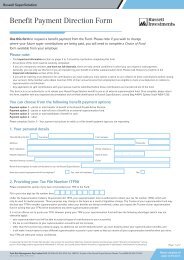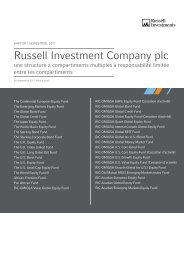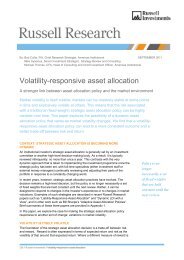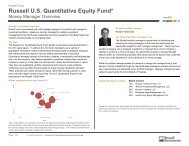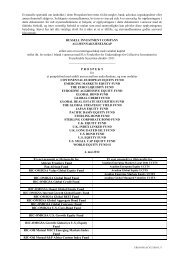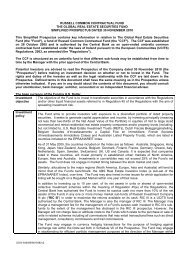Implementing LDI with swaptions - Russell Investments
Implementing LDI with swaptions - Russell Investments
Implementing LDI with swaptions - Russell Investments
You also want an ePaper? Increase the reach of your titles
YUMPU automatically turns print PDFs into web optimized ePapers that Google loves.
RUSSELL INVESTMENTS<br />
In today’s low interest rate environment,<br />
many plan sponsors have been reluctant<br />
to fully eliminate the interest rate risk<br />
in their plans but have preferred a more<br />
incremental approach to <strong>LDI</strong>. In this sense,<br />
one application of LRAA is to increase<br />
the duration of a plan’s fixed income<br />
investments incrementally as the allocation<br />
to fixed income increases overall. 2 While this<br />
approach has some merit, the unfortunate<br />
outcome for most plans in the very early<br />
stages of their LRAA and/or <strong>LDI</strong> programs<br />
has been that they remain in very shortduration<br />
positions vis-à-vis liabilities, and<br />
funding levels have suffered in the recent<br />
declining interest rate environment.<br />
The ultimate goal in an <strong>LDI</strong> portfolio is to<br />
increase the duration exposure of fixed<br />
income investments, and we know that<br />
plan sponsors want protection against<br />
declining interest rates. One version of a<br />
swaption trade—the “zero-cost collar,”<br />
discussed below—provides this type of<br />
exposure by offering protection against<br />
declining interest rates in exchange for the<br />
promise to enter a swap at a certain interest<br />
rate above current rates. While there are<br />
many moving parts in this version, these<br />
higher rates can potentially be aligned at<br />
levels along the LRAA schedule, where<br />
the plan sponsor would be increasing the<br />
duration exposure of the fixed income<br />
portfolio in any case.<br />
An example of a swaption trade:<br />
the zero-cost collar<br />
The swaption trade we describe below is<br />
based on buying a receiver swaption at a<br />
low interest rate (to offer the protection<br />
we’d like to have, should rates fall) matched<br />
by selling a payer swaption 3 at a higher<br />
rate (the rate at which we are likely to be<br />
seeking longer-duration exposure anyway).<br />
For convenience, the terms of the two deals<br />
can be chosen such that the premium paid<br />
for buying the protection of the receiver<br />
swaption is equal to the premium collected<br />
for selling the payer swaption.<br />
Exhibit 1: Rates<br />
Swap curve date 8/30/2011<br />
10y (spot) 2.36<br />
3y10y (forward) 3.41<br />
Source: Bloomberg<br />
Exhibit 2: Strategies<br />
Strategy<br />
Zero-cost<br />
swaption<br />
collar<br />
Payer<br />
strike<br />
Receiver<br />
strike<br />
A 3y10y+50 3.91 3.04<br />
B 3y10y+100 4.41 2.70<br />
C 3y10y+150 4.91 2.38<br />
D 3y10y+200 5.41 2.10<br />
Source: Bloomberg<br />
The interest rates associated <strong>with</strong> such<br />
a trade, as of August 30, 2011, are shown<br />
in Exhibit 1. At that date, the at-themoney-forward<br />
(ATMF) rate was 3.41% 4 .<br />
In Exhibit 2, the payer swaption strikes<br />
at 50-basis-points-higher increments are<br />
3.91%, 4.41%, 4.91% and 5.41%. The<br />
strike shown for the receiver swaption is<br />
in each case the strike that results in an<br />
equal premium for the two <strong>swaptions</strong> (i.e.<br />
creating a zero-cost collar).<br />
In Exhibit 3, we illustrate the effect of<br />
these strategies by looking at the impact<br />
of interest rate shock at option expiration<br />
on an example plan that is 80% funded.<br />
The first thing we note is that all of the<br />
swaption strategies reduce the impact of<br />
interest rate variation on the funded status<br />
of the plan. This should not be a surprise:<br />
in each example strategy there is a built-in<br />
exposure to interest rates, so it becomes a<br />
de-risking strategy for any DB plan whose<br />
liabilities are driven by interest rates.<br />
2<br />
For a description of this<br />
strategy, see Jim Gannon<br />
& Bob Collie (2009),<br />
“Liability-Responsive<br />
Asset Allocation,” <strong>Russell</strong><br />
Viewpoint.<br />
3<br />
A payer swaption being<br />
the right to pay the fixed<br />
rate and receive the<br />
floating.<br />
4<br />
This can be thought of<br />
as the 10-year swap rate<br />
which current pricing<br />
implies the market expects<br />
in three years’ time.<br />
p / 5



